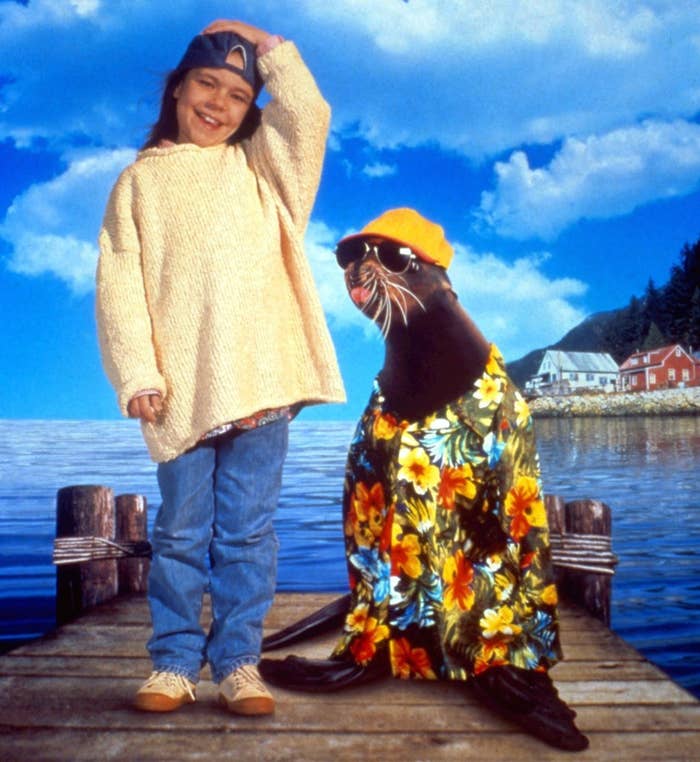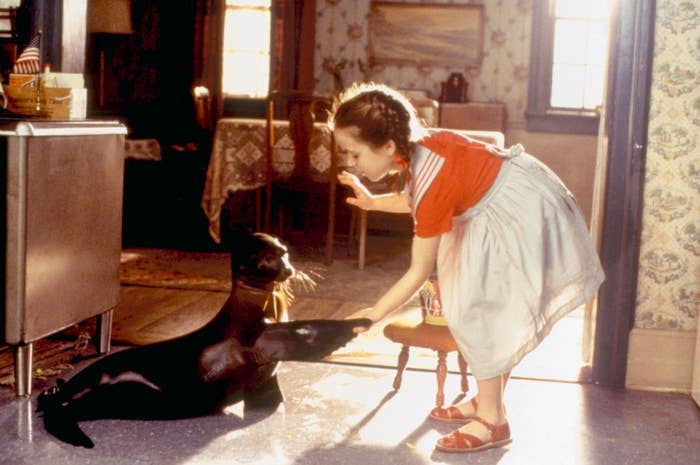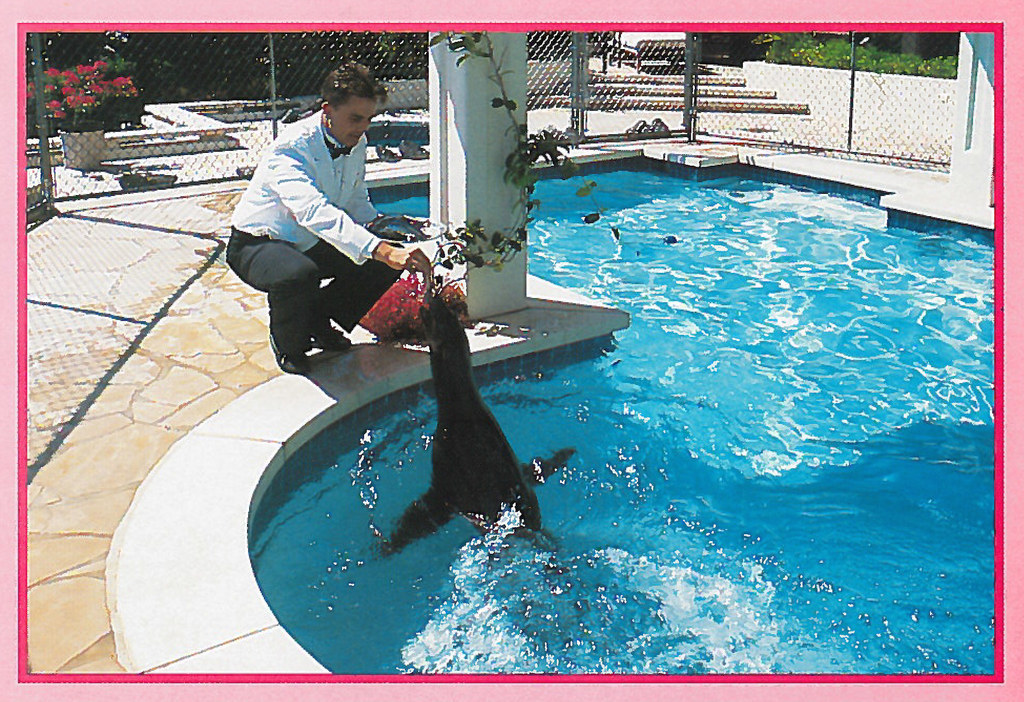
By now, the story of Andre has become a cliché: A wild animal rescued by humans becomes part of a human family, teaching them a thing or two about kindness and morality along the way. But unlike many of its kind, this particular children's movie had a beguiling tagline: "based on a true story." Chronicling the life of a friendly seal, Andre came out in the summer of 1994 — coincidentally a little over a year after Free Willy, which was not enough time to escape unfavorable comparisons ("the movie doesn't have the smarts of Free Willy," wrote a scornful Roger Ebert). To a child, the differences between the films were obvious: Yes, both were about marine mammals that befriended humans who later released them into the wild, but Willy the killer whale clearly embraced his freedom, whereas Andre came back. In a way, it made Andre more appealing. You could do the right thing, and your animal friend might not take you up on the offer. You might just stay best friends forever.
That was my impression. I was a small child, and I was enchanted. Andre had not only heroic people who rescued a sea creature from certain death in the maw of a great white shark, but also a seal who could straddle both worlds — he was wild and tame, a free homebody. The movie was based on a true story — the true life of a kid who truly was friends with a seal. An adult gave me the movie on VHS and I watched and rewatched it. That could be me, I thought for a few years, and then I rarely thought about it again except as a half-remembered sweet story.
And then it was 20 years later, and there it was on the Wikipedia page "1994 in Film," sandwiched in the August section between two movies I had not seen because I was tiny then. Where is that creature now? I wondered. The answer: The sea lion who played Andre in the moderately successful children's film is buried near an enclosed pool of other sea lions on a Bahamian cay, while Andre himself is still buried in a backyard in Maine near several family pets. Tory, the late, washed-up movie star, had traveled internationally, survived two natural disasters, and died in the Caribbean; Andre had died at 25 in Maine. Each animal brought meaning to the lives of the people they touched: Tory was beloved by her trainers, while Andre spent 25 years as an unofficial harbormaster and lumpy mascot. Their memories have both been preserved by the silver screen, but in order for that to happen, some things had to be forgotten.
The open secrets of Rockport Harbor
The real Andre lived with the amateur naturalist Harry Goodridge and his family from 1961 until his death in 1986 — by the time Goodridge plucked his body off the shore about eight miles from the family home in Rockport, Maine, the harbor seal had achieved enough celebrity to have a small obituary in the New York Times. The Camden-Rockport Chamber of Commerce named him Townsperson of the Year in 1979, the same year that the seal's high profile made him a campaign stop in Maine's gubernatorial race. He was beloved and biopic-worthy because, as Goodridge puts it in his book, the animal "of his own free choice passed up the opportunity to return to the wild." Although Andre could have left Rockport Harbor, he always swam back. It was particularly impressive when the Mystic Aquarium in Connecticut released him from one of his winter stays in various sea parks and he made the 300-mile swim back up the coast. Harbor seals are generally nonmigratory, but Andre was inexorably drawn back to Rockport, like the tide itself.
The seal's migrations made it into the movie, but the cuteness of the narrative could only function with certain facts omitted. In his autobiography, A Seal Called Andre, Goodridge explains that, fixated on having a seal diving companion, he had captured two baby seals before Andre. The first he unintentionally starved for a little while before he thought of soaking a wet rag in milk to feed the animal; shortly thereafter, a necropsy revealed that the seal had died after swallowing a piece of towel. ("There was certainly no Dr. Spock on the care and feeding of baby harbor seals available," he explained, as if "don't take baby harbor seals to your house" wasn't Dr. Spock enough.) Goodridge's second seal was eaten by a great white shark while swimming with his caretaker; Goodridge killed the shark, avenging the animal's natural predatory behavior. These first two pups and the seals he captured and raised after he found Andre in 1961 — Luigi, who died in an aquarium, and Jesse, whom he "acquired" after soliciting the U.S. Navy for support in a project — were not mentioned in the 1994 film. A recent PBS documentary on Andre made a choice similar to the fictionalized movie's: Just as Andre lets the meeting happen by chance, so the documentary calls Goodridge's sighting of Marky, his first seal, a "fateful encounter," glossing over the fact that Goodridge was actually seeking a seal. The documentary does not mention the shark victim — Basil — nor Luigi, nor Jesse.
Goodridge believed both that very young animals "adopted by man have difficulty in identifying with their own kind" and that Andre came and went "as he please[d]" — not acknowledging that the former made the latter seem more desperate than sweet. His contention that Andre came back to Rockport of his own volition was a factor in why the arborist and freelance scuba diver wasn't prosecuted under the 1972 Marine Mammal Protection Act, which ordinarily would prohibit basement sleepovers with harbor seals. Goodridge also insists in his book that the National Marine Fisheries Service was put off enforcing the law by the outcry from the enchanted public that would surely follow his separation from the seal who swam so far to be with him.

Hollywood comes calling
Dana Baratta, the film's screenwriter, was part of that enchanted public. As a child, she watched Goodridge direct Andre's tricks in his pen. "Seeing the girls, his daughters, I was just so jealous," Baratta told BuzzFeed News. "I wanted to be in that pen, helping with the training of Andre." It was a compelling image that followed her to adulthood; she was fascinated by Goodridge and his insistence on letting Andre live in the harbor. "What was that '70s [slogan] — if you love something set it free?"
Like Baratta, Suzanne Fortier, the head trainer on the movie, had a history with the harbor seal. "When I was a little girl, I actually met the real Andre," she said. "Fast-forward to 30-some years later, I'm training sea lions. It was full circle for me." Fortier, who had worked in Magic Mountain's now-closed Aqua Theater in Valencia, California, for nearly a decade, wanted Andre to be her last hurrah with the sea lions, she said, because she'd decided to stop training animals: "I wasn't bonded to humans the way I was bonded with the animals" — it was a magical time, but it couldn't last.
The fiction of the movie starts at the most basic level: A movie seal is ever-docile, but outside the movies, the National Marine Fisheries Service guideline is "do not approach seals and sea lions." Andre's animal coordinator, Brian McMillan, said he cast the lead animal, Tory, and the sea lions who doubled for her because they were "safer to be around kids" — the film starred then-9-year-old Tina Majorino as Toni, Andre's little kid best friend. "Most people don't realize sea lions have a very dangerous bite," McMillan said, while Majorino wrote in an email statement to BuzzFeed News, "That time in my life was so special and it will always remain close to my heart" — filming with sea lions was a child's "dream."
After they were cast in the movie, the sea lions were driven in trucks from the theme park where they lived back to Los Angeles and then flown to Canada in the cargo hold of a plane; they arrived at least a month before filming began so that they could get used to their new saltwater pools on the Vancouver soundstage. They couldn't really shoot on location, in part because "the aroma of sea lion is pungent," as Thomas Burstyn, Andre's director of photography, said; relatedly, sea lions won't be housebroken. Baratta remembered that during the scene in which Toni says a tearful good-bye to Andre, Majorino's tears were caused by the terrible smell of the animal.
Burstyn, a member of the New Zealand Cinematographers Society, had worked with animals before, and found that this time wasn't very different. "Working with sea lions is a lot like working with a cheetah or dog — they were all just trouble," he said. He had previously worked on Cheetah, a 1989 children's film about a big cat rescued by humans. Because animals are unpredictable, the final product is a function of "the wonder of editing," and not what it seems to be: the result of a perfectly compliant animal.
Burstyn's favorite scene, he said, was toward the end of the film, when Andre is swimming back to Rockport Harbor to be with the Goodridge family, leaping out of the water in arcs. The scene could not be shot in the open ocean for fear of Tory's escape; instead, they filmed in an indoor pool outfitted with obstacles for her to hurdle over to achieve the triumphant swim home that embodies the movie's tagline, The greatest adventure is finding your way home. "It was amazing how beautifully it swims," Burstyn said. That was also Fortier's favorite scene: "I cried when I saw that footage, because I saw the beauty of her."
The project was over quickly: The film shot in the early months of 1994 and was released in August of the same year. It was not a huge success, but it did make almost $17 million at the box office — Baratta called it an overall win, considering it was a low-budget film. She was a little disappointed that it was not the sort of movie that appealed to adults as well as children; it was unsophisticated. Still, she said, "There's a new batch of 7-year-olds who enjoy it every year."
The first year those kids had a chance to imagine themselves befriending and then freeing a seal who ultimately prefers the company of human children to life in the wild, Tory and another sea lion were flown to Hawaii with Fortier for the movie's press junket; they stayed at a five-star hotel, swimming in the private pool of a bungalow and being waited on by a butler when they weren't meeting with reporters. "We serve all sorts of guests here," said Susan Bredo, the marketing manager at the Mauna Lani Bay Hotel & Bungalows, who sent a photograph of a sea lion eating a fish from the hand of a butler in a crisp white jacket. Bredo recalled erecting a chain-link fence around the bungalow before the sea lions famous for playing a wild seal could take up residence there. The bungalow overlooks the ocean, she said, explaining that the sea lions would be drawn to the smell and might escape if there were no fence to stop them.

The one-hit wonder flies south
Because the Aqua Theater had been destroyed by an earthquake in January 1994, after Hawaii, Tory returned to the Gulfport, Mississippi, headquarters of Marine Animal Productions, a company that contracted out sea lion and dolphin acts to aquariums and zoos and, in this case, to a film. She lived in MAP's Marine Life Oceanarium until 2005, when Hurricane Katrina crushed it. Some of the animals, including Tory, were evacuated from the facility the day before the storm hit the Gulf states — the animals who were left in the park did not fare very well, including Tory's son Andre, who was later discovered behind a casino in Mississippi and was sent to the Memphis Zoo, where paintings made by the 700-pound animal are available at auction.
The storm ended the company that owned Tory; the animal inventory was sold and shipped to the Bahamas. Most of them went to the Atlantis Resort on Paradise Island, but Tory and five other sea lions were flown to a park on a Bahamian cay northeast of New Providence Island owned by a German entrepreneur who made his fortune in groceries. Kim Terrell, once the director of Marine Animal Productions, had reached out to her former employer after the storm. Now the director of marine mammals at Dolphin Encounters on Salt Cay, unofficially "Blue Lagoon Island," she offered to bring six of the California sea lions to the tropics. "My ultimate goal was to establish a breeding group," she said, and she selected five individuals who would make good candidates for breeding in captivity: four females and one male.
"Tory, however, was my special case," she said. "Because she had a little piece of my heart." Much like Andre, Tory was a natural charmer — his charm saved him from likely dying an orphan, hers got her a one-way ticket to the West Indies, accompanied by animals who would propagate the captive population. By the time she made it to the Caribbean in September 2006, she had endometriosis, Terrell said, and though she'd had "several babies" before, it was clear that she wouldn't have a pup at Dolphin Encounters.
Terrell's voice broke. "I knew when I got her, she was not a breeding candidate because of her breeding problems, but I wanted her to have a good home."
Tory lived in the natural saltwater lagoon for two years — the tide flowed in from the ocean in three areas, the water was 30 feet deep, and Terrell instructed the trainers to leave everything in the same place so that the now-blind sea lion wouldn't bump into things. Tory continued doing shows and meet-and-greets right up until a week before her death. She died June 20, 2008, just before her 23rd birthday — her kidney and heart failed, Terrell said. "She is buried on the hill on our island so always close," Terrell wrote in an email.
Tory's grave is a parallel to Andre, whose human friends buried him in the ground as well, foregoing the traditional pinniped sea burial. Even in death, they were kept near people, their final, endless performance still one of humanity.
"I think the time is complete for captive animals," Tory's old trainer Fortier said thoughtfully. "It's a new generation." A new generation, perhaps, that learned a thing or two about freedom from the performing animals in movies — as little Toni observed in Andre, "He is a wild animal, you know, so I think he'd like it better in the wild." Despite the morals of films like Free Willy and Andre, the time for captive animals is clearly not, as Fortier intimates, done. Milo, the first sea lion pup at Dolphin Encounters, was born three days after Tory's death. Eight pups have been born since. Milo and the other pups born on Salt Cay love to catch the fish that swim in from the open sea, but they don't eat them, Terrell said. They just play with them.
